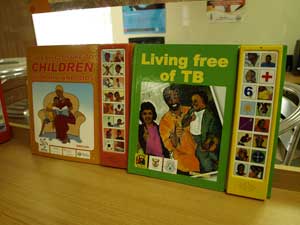By Francesca Merico, Volunteer Coordinator, HAART for Children Campaign, Caritas Internationalis Delegation to the UN in Geneva
Every year, on 24 March, the international community observes World TB Day. This year Caritas is calling for more children living with tuberculosis to be diagnosed, treated and cured.
 What is the scale of the problem?
What is the scale of the problem?
According to the World Health Organization (WHO), one-third of the world’s population is infected with TB. Out of this, 1 in 10 will develop TB during their lifetime. Today, TB remains one of the most serious epidemics in much of the world, causing the deaths of nearly one-and-a-half million people annually. And every year, there are an estimated 9 million new TB cases with 1.5 million deaths annually, mostly in developing countries.
Why is CI focusing on childhood TB?
Caritas launched the HAART for Children Campaign in 2009, aimed at the early diagnosis and treatment of women and children with HIV. Since then, Caritas has advocated for more attention to childhood TB since TB is the number one “killer” among children living with HIV. We want children with TB to be reached, treated and cured. TB is curable. This is an important message we must spread: If you diagnose TB, it can be treated in 6 months. However, childhood TB is still overlooked by many public health authorities, TB control programmes, policy makers and donors.
Simple but vital messages about tuberculosis should be included in integral development and empowerment programmes. They should encourage people to recognise the symptoms of TB and refer people experiencing such symptoms for medical help. Let us not forget that most people living with TB, up to 99 percent, live in very poor settings. Thus TB is known as a disease of poverty and should be a priority concern for Caritas and other Catholic Church-inspired and civil society organisations.
What about children?
Those most vulnerable to falling ill with TB are very poor, malnourished or undernourished people, people living with HIV/AIDS, women, migrants, prisoners, refugees and internally displaced persons, miners, the elderly, ethnic minorities, indigenous populations, drug users, homeless persons and large numbers of children.
The most recent estimates of WHO indicate that at least 1.5 million children become ill with tuberculosis each year and that, on an annual basis, up to 80,000 children die of TB. Sadly, the actual burden of TB in children is probably higher, given the difficulty with diagnosing this infection in children. In addition, there is a lack of information about HIV/TB co-infection in children. We know that in Africa the majority of patients with TB are also HIV-positive, and that these overlapping epidemics accelerate illness and death. However we do not have a clear picture of the burden of HIV/TB co-infection in children.
What is needed to achieve the aim of World TB 2015, especially with regard to paediatric TB?
One of the major challenges presented by TB is that it is very difficult to confirm whether or not a child is living with this infection. In most countries, health care workers are still forced to rely on diagnostic methods that were developed 130 years ago. We definitely need better diagnostic tools for children. Also, we need to train health and community care workers to identify TB in children even without the most modern diagnostic tools, looking for instance at malnutrition, HIV/AIDS and TB cases in the family. Children do not infect others with TB but they do contract this infection from adults, usually within their own household.
We need to promote active outreach in countries where HIV and TB are prevalent. In such locations, programmes should provide testing for both infections to all infants and children as well as to their mothers and families. Moreover, in settings where HIV and TB are highly prevalent, children should be protected against TB with a six-month course of preventive, treatment, which consists in a daily dose of a medicine called isoniazid. Such treatment is inexpensive and simple but quite effective.
As often occurs with paediatric HIV infection, children living with TB do not have easy and inexpensive access to “child friendly” TB medications. Indeed, we need treatment formulations for TB that are appropriate for use in children living in low-income settings as well as “child-friendly” treatment formulations for TB/HIV co-infection in children.
TB is responsible for the deaths of many children each year. These deaths are preventable. This news should be spread widely: “TB is curable! if you diagnose it, it can be treated within 6 months.
Learn more about the global response to TB, with particular attention to the impact of this disease on children. Download the 6th Edition of Caritas Internationalis HAART for Children Newsletter, which was released to coincide with 2015 World TB Day
